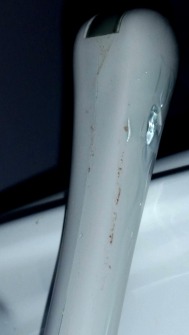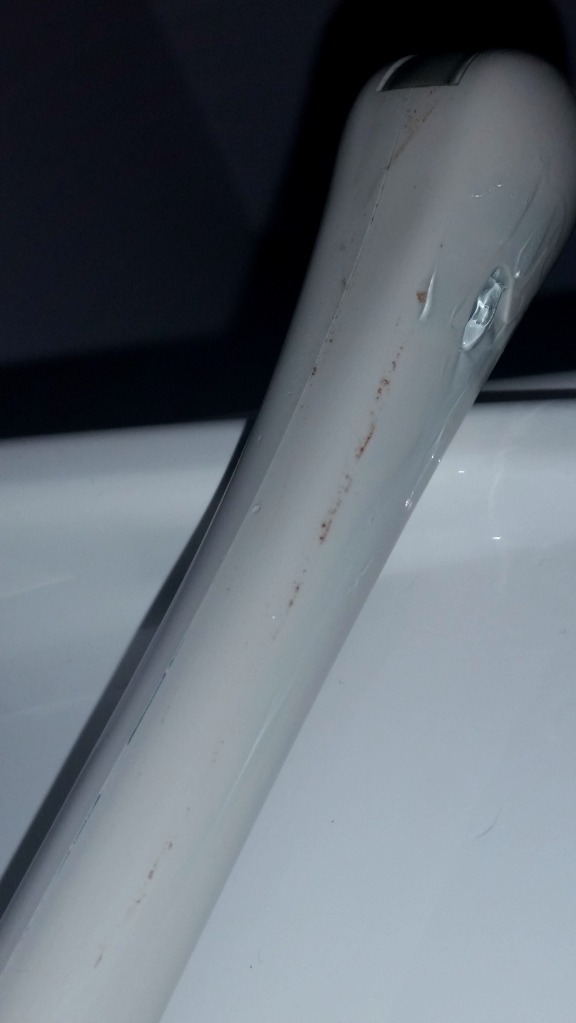
Post procedural transvaginal probe: contaminated surface despite the use of a probe cover.
Probe sheaths are often used with endocavity ultrasound transducers to prevent disease transmission between patients, however; studies have shown probe cover leakage of up to 81% [4,5,9,10,11]. For that reason, probe covers are required to be used in conjunction with high level disinfection (HLD) of endocavity probes.
But, what does it mean for a chemical to be termed a ‘high level disinfectant’ versus a ‘low level disinfectant’ or sterilant?
“ FDA defines a high level disinfectant as a sterilant used under the same contact conditions except for a shorter contact time. Therefore, products with high level disinfectant claims should first qualify as a sterilant by passing the Association of Official Analytical Chemists (AOAC) Sporicidal Test (Sporicidal Activity of Disinfectants, AOAC 6.3.05:1995, Official Method 966.04) ..”
You’d probably be pretty surprised to find out that the characterization of a chemical as an HLD is not specific to its use; in other words, they are NOT tested for the diseases to which they will most likely be exposed and employed to kill. Well, it shouldn’t have come as much of a surprise when earlier this year, research conducted by Meyers et al, demonstrated the impotence of the 11 most commonly employed high level disinfectants against human papillomavirus-16 (HPV); the strain linked to cervical and oropharyngeal cancers [1]. Among the chemicals that were ineffective at deactivating HPV-16 were glutaraldehyde and ortho-phthalaldehyde (OPA). These chemicals are characterized by the FDA as high level disinfectants and recommended by the CDC [2] for HLD of semi critical items. As a result, they are widely utilized for HLD of transvaginal, transrectal, transesophageal probes, and flexible endoscopic probes; we know these chemicals by their product names: Cidex Plus, Cidex OPA, Metrocide etc.
The alarming rate of probe cover failure nearly guarantees probe surface exposure to pathogens;combine that with an ineffective HLD and you’ve a recipe for diseased disaster and provider liability which necessitates immediate mitigation through HLD revision at the Federal Level.


The images above show an endocavity transducer following a transvaginal examination I performed. The images were taken immediately after removing the probe cover- just prior to HLD. Clearly, there is contamination of the probe surface that occurred despite the use of a barrier. If I was using Cidex/Metrocide, and my patient was previously exposed to HPV (an estimated 25% of people) it would remain on the surface of the probe even after HLD. Its only logical to conclude that, since blood FROM the patient was able to penetrate the sheath and contaminate the surface of the probe, that any pathogens that survive the HLD process could also be transmitted in kind, TO the next patient. (Luckily, my organization was proactive and is using a vaporized Hydrogen Peroxide system which does kill HPV) we bought through GE at the time, however; I heard they can now be purchased directly from Nanosonics.
For those of you still only performing low level disinfection (LLD) on transvaginal probes–look again at the images above and imagine that probe being used on you after only being cleaned with a spray and/or wipes. LLD guarantees you are giving your patients more than an ultrasound examination; you are transmitting disease to your patients.
Sadly, the CDC is aware that the chemicals they recommend are inadequate and pose serious risk to patients. Their guidelines are the very basis upon which most health care organizations develop their infection control measures in an effort to ensure patient safety; making the CDC’s failure to react and revise their recommendations even more egregious. There alternatives to CIDEX PLUS and CIDEX OPA on the CDC’s list that can be instituted to process intracavity ultrasound probes. Great organizations shouldn’t have to be forced to take the most progressive approach in patient safety measures. The CDC might be taking their time, at the expense of patients’ health; you don’t have to.
References
[1]Ryndock E, Conway M, Meyers C, Robison R Meyers J, “Susceptibility of high-risk human papillomavirus type 16 to clinical disinfectants,” Susceptibility of high-risk human papillomavirus type 16 to clinical disinfectants, The journal of antimicrobial chemotherapy vol. 69, no. 6, pp. 1546-1550, 2014.
[2]Ph.D., M.P.H., David J. Weber, M.D., M.P.H., and the Healthcare Infection Control Practices Advisory Committee William A. Rutala, “Draft Guideline for Disinfection and Sterilization in Healthcare Facilities,” Atlanta, 2/20/2002.
[3]Casalegno J. et al, “High Risk HPV Contamination of Endocavity Vaginal Ultrasound Probes: An Underestimated Route of Nosocomial Infection?,” PLoS ONE, vol. 7, no. 10, 2012.
[4]S Leroy, “Infectious risk of endovaginal and transrectal ultrasonography: systematic review and meta-analysis,” Journal of Hospital Infection, vol. 1, no. 8, 2012.
[5]Fisch, J Milki A, “Vaginal Ultrasound Probe Cover Leakage: Implications for Patient Care,” Fertility and Sterility, vol. 69, no. 3, pp. 409-411, 1998.
[6]et al Hutchinson J., “Burkholderia cepacia Infections Associated With Intrinsically Contaminated Ultrasound Gel: The Role of Microbial Degradation of Parabens,” Infection Control and Hospital Epidemiology, vol. 25, no. 4, pp. 291-296, 2004.
[7]M Lin, “Investigation of a pyoderma outbreak caused by methicillin-susceptible Staphylococcus aureus in a nursery for newborns,” Journal of Hospital Infection, vol. 57, no. 1, pp. 38-43, 2004.
[8]Marue´jouls C, Abachin E, et al. Gaillot O, “Nosocomial outbreak of Klebsiella pneumoniae producing SHV-5 extended-spectrum betalactamase,originating from a contaminated ultrasonography coupling gel,” J Clin Microbiology, vol. 36, pp. 1357-1360, 1998.
[9]Raine-Fenning N Sahu B, “Ultrasound and the risk of nosocomial cross infection,” Ultrasound in Obstetrics & Gynecology, vol. 36, no. 2, pp. 131-133, 2010.
[10]Ruddy M, Kibbler CC, Economides DL, MacLean AB. Amis S, “Assessment of condoms as probe covers for transvaginal sonography.,” J Clin Ultrasound , vol. 28, pp. 295-298, 2000.
[11]MD Guillaume Kac et al., “Evaluation of Ultraviolet C for Disinfection of Endocavitary Ultrasound Transducers Persistently Contaminated despite Probe Covers,” Infection Control and Hospital Epidemiology , vol. 31, no. 2, 2010.









You must be logged in to post a comment.